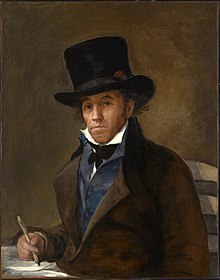Portrait of Asensio Julià (1798)

Portrait of Asensio Julià is the title of a painting by Francisco de Goya that was probably made around 1798. In 1814 Goya painted another portrait of his friend. The work belongs to the collection of the Museo Thyssen-Bornemisza in Madrid.
Description and background
In portrait format, the work measures 54.5 × 41 cm. It is executed in the painting technique oil on canvas , in Goya's catalog raisonné by José Gudiol it is listed under 1970, no. 378 [1980; No. 359]; in Gassier and Wilson 1971, no. 681; in De Angelis 1974, no. 345. Goya provided the work with the dedication Goya a su amigo Asensi ( Goya to his friend Asensi ). This dedication and the background of the picture, which shows wooden scaffolding and beams, as well as brushes and other tools of the painter's profession on the floor, lead to the conclusion that the subject is the painter Asensio Julià from Valencia (1760-1832) acted who assisted Goya in the work on the frescoes of the Ermita de San Antonio de la Florida in Madrid at the time when this portrait was created.
In the first half of 1798 Francisco de Goya painted the portraits of Andrés Peral, which were shown in the Academy's exhibition that summer, as well as that of Gaspar Melchor de Jovellanos and that of Asensio Juliá.
Provenance
Provenance : The work was first listed in 1846 in the inventory, which was written by Vincente Lopéz; At that time it was shown in the Royal Palace Vista Alegre in Carabanchel near Madrid. In 1832 the painting was acquired by Queen Maria Christina , from whom her daughters in 1846 and in 1858 her younger daughter, the Infanta Luisa Fernanda and her husband Prince Antoine d'Orléans, duc de Montpensier , owned the Vista building Alegre was. The businessman Don José de Salamanca bought this in 1859; the inventory and the paintings convicted the pair subsequently in the San Telmo Palace in Seville , listed in an inventory catalog of 1866. There it was from 1859 to 1897. Prince Antoine d'Orleans kept it from 1897 to 1922 in Sanlúcar de Barrameda on . The Parisian art dealer Paul Durand-Ruel acquired it on January 27, 1911; on October 17, 1912, it went to Durand-Ruel's New York City branch. The investment banker, art collector and philanthropist Arthur Sachs (1880–1975) acquired it on April 6, 1923 in Paris. At an auction at Sotheby’s in London, Ovsievski bought it for £ 170,000 for the Thyssen-Bornemisza Collection in Lugano; since 1992 it is left in the Museo Thyssen-Bornemisza .
reception
The art historian Elsbeth Wiemann (1989) judged: “The unpretentious attitude of the painter dressed in a work smock emphasizes the decidedly private character of the picture, in which Goya openly expresses his sympathy for the sitter. Although little more than a quickly thrown sketch, the work captivates with the masterful use of means. The fleeting, sketching style of painting and the luministic effects give the portrait its very own, almost impressionistic -looking note. "
Web links
- Portrait of Asensio Julià in the database of the Museo Thyssen-Bornemisza
- Portrait of Asensio Julià in the Cultura España database
Individual evidence
- ↑ José Gudiol: Goya. 1746-1828. Translation from Spanish by Kenneth Lyons. Tudor Publishing Company, New York 1971, OCLC 638811232 . (Biography, Analytical Study and Catalog of his Paintings)
- ↑ Jose Gudiol: Goya 1746-1828. Volumes I. and II. Biografia, Estudio Analitico y Catalogo de sus Pinturas. Ediciones Poligrafa, SA, Barcelona 1980, ISBN 84-343-0313-2 .
- ^ Pierre Gassier, Juliet Wilson: Francisco Goya. Life and work. Office du Livre, Friborg 1971.
- ^ Rita de Angelis: La obra pictorica completa de Goya. Editorial Noguer, Barcelona / Madrid 1974.
- ↑ José Gudiol: Goya. Ediciones Poligrafa, Barcelona 2008, ISBN 978-84-343-1174-9 , p. 57.
- ↑ Arthur Sachs, 95, Ex-Broker, dead. Obituary. In: New York Times. March 8, 1975.
- ↑ Francisco Goya, Manuela Mena: Goya: el capricho y la invención: cuadros de gabinete, bocetos y miniaturas. Museo del Prado, 1993.
- ↑ Gary Tinterow, Genevieve Lacambre: Manet / Velazquez: The French Taste for Spanish Painting . Metropolitan Museum of Art, New York 2003, p. 411.
- ^ Marginalia: Zeitschrift für Buchkunst und Bibliophile, issues 44–46, Pirckheimer-Gesellschaft, 1971.
- ↑ Elsbeth Wiemann was senior curator for old German and Dutch painting at the State Gallery in Stuttgart. See Uta Baier: From church painter to peasant warrior Jerg Ratgeb: The once forgotten painter is being rediscovered today. in Kulturstiftung.de
- ^ Albert Boesten-Stengel, Bernhard August Rave, Elsbeth Wiemann: Masterpieces from the Thyssen-Bornemisza Collection: Paintings from the 14th to 18th centuries. Staatsgalerie Stuttgart, December 10, 1988 - March 5, 1989 (an exhibition by the Thyssen-Bornemisza Foundation and the Stuttgart State Gallery)
